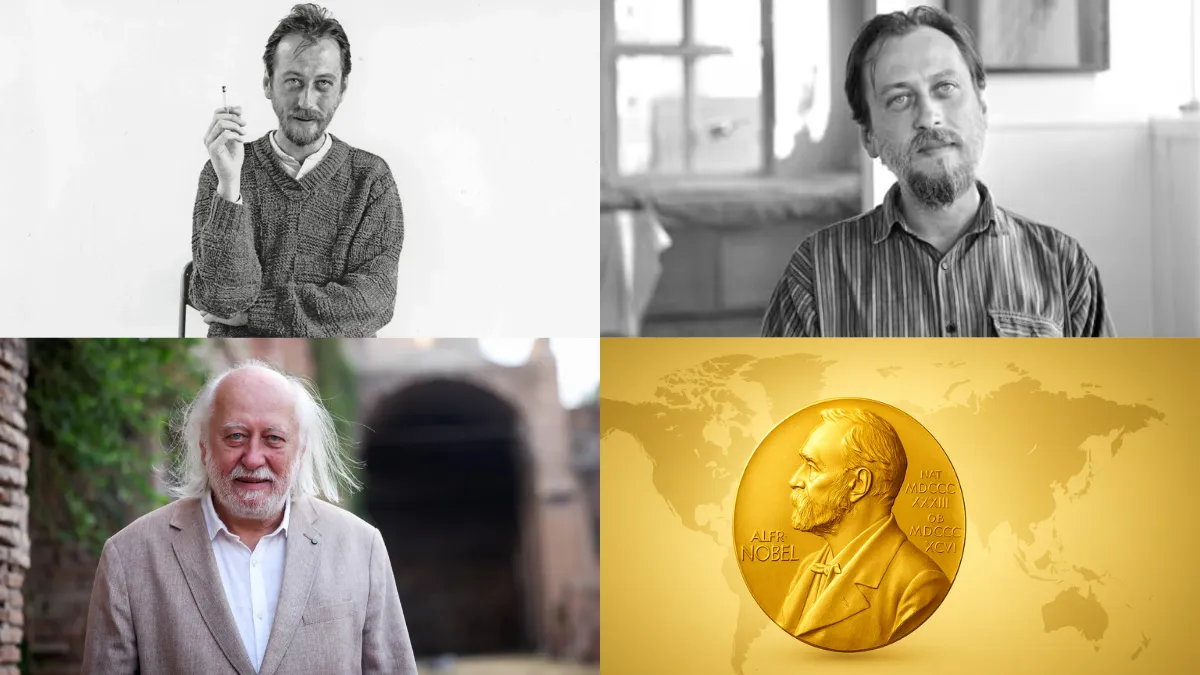Early Life and Beginnings in Hungary
László Krasznahorkai, one of the most acclaimed contemporary writers, was born in 1954 in the small town of Gyula, situated in southeast Hungary near the Romanian border. Growing up in a remote rural area, Krasznahorkai experienced the quiet and isolation of village life, which later became a recurring motif in his literature. These early surroundings inspired his first novel, Sátántangó (1985), which would mark his literary breakthrough and establish him as a unique voice in Hungarian and global literature.
Satantango portrays a destitute community living on an abandoned collective farm in the Hungarian countryside, just before the fall of communism. The novel captures the silence, anticipation, and hopelessness of the residents as they await change. When the charismatic Irimiás and his accomplice Petrina, long thought dead, reappear, they bring with them the tension of hope and dread. The “satanic” aspect of the story lies in their manipulative, almost hypnotic power over the villagers, who are entangled in illusions and deceptions. This novel’s haunting Kafkaesque tone, punctuated by the motto “In that case, I’ll miss the thing by waiting for it,” makes it a masterpiece of apocalyptic literature.
The novel gained further fame when it was adapted into a highly original film in 1994 by the celebrated Hungarian director Béla Tarr, cementing Krasznahorkai’s reputation as a master of dark, immersive narratives.
Rising Recognition: The Master of Apocalypse
Following the success of Sátántangó, Krasznahorkai released his second novel, Az ellenállás melankóliája (1989; The Melancholy of Resistance, 1998), which drew immediate international attention. American critic Susan Sontag dubbed him the “master of the apocalypse” after reading this work. Set in a small Hungarian town in a Carpathian valley, the novel’s feverish and surreal narrative depicts a ghostly circus whose main attraction is the carcass of a giant whale.
The arrival of the circus triggers a wave of chaos, violence, and vandalism, highlighting the fragile balance between order and disorder. Through grotesque characterizations and dreamlike sequences, Krasznahorkai captures humanity’s vulnerability to social upheaval and collective hysteria. Military forces are powerless, suggesting the lurking possibility of dictatorship. In this work, he masterfully portrays the tension between societal control and the destructive forces of human nature.
Expanding Horizons: War & War and Baron Wenckheim’s Homecoming
In Háború és háború (1999; War & War, 2006), Krasznahorkai moves beyond Hungary, following the humble archivist Korin as he journeys from the outskirts of Budapest to New York in search of a rare ancient epic. The novel emphasizes his signature style: long, flowing sentences without full stops, creating a hypnotic, almost breathless narrative rhythm.
This thematic exploration of return and discovery anticipates his later work, Báró Wenckheim hazatér (2016; Baron Wenckheim’s Homecoming, 2019). Here, the story revolves around the baron, a hopelessly infatuated gambler returning to Hungary after years in exile in Argentina. Expecting to reunite with his childhood love, he places his trust in a treacherous companion, Dante, reminiscent of a grimy Sancho Panza. Krasznahorkai’s prose captures the tension between hope and disillusionment, culminating in a comic yet melancholic reception by the local community — a striking example of his ability to blend tragedy and humor.
Modern Epic: Herscht 07769
Krasznahorkai’s Herscht 07769: Florian Herscht Bach-regénye (2021; Herscht 07769: A Novel, 2024) represents his contemporary approach to epic storytelling. Set in a small town in Thüringen, Germany, the novel explores social unrest, murder, and arson, while simultaneously reflecting the legacy of Johann Sebastian Bach. The protagonist, Herscht, is portrayed as a credulous, big-hearted figure, reminiscent of Dostoyevsky’s holy fools, navigating the chaos wrought by society’s unseen forces.
The novel is written in a single, continuous breath, blending violence and beauty in a way that feels both impossible and mesmerizing. Its dénouement illustrates Krasznahorkai’s hallmark unpredictability, showing that even in a structured narrative, chaos and chance can reshape the course of events.
Influences and Literary Tradition
László Krasznahorkai is deeply rooted in the Central European literary tradition, drawing influence from Kafka, Thomas Bernhard, and Dostoyevsky. His works often feature absurdism, grotesque excess, and apocalyptic landscapes. Yet, Krasznahorkai is not limited to bleak depictions; he also explores contemplative and lyrical tones inspired by his travels to the East.
In works such as Északról hegy, Délről tó, Nyugatról utak, Keletről folyó (2003; A Mountain to the North, a Lake to the South, Paths to the West, a River to the East, 2022), Krasznahorkai’s prose takes on a mysterious, lyrical quality. Set southeast of Kyoto, the novel serves as a prelude to Seiobo járt odalent (2008; Seiobo There Below, 2013), a collection of seventeen stories exploring beauty, artistic creation, and impermanence.
Seiobo There Below: Art, Myth, and Creation
Seiobo There Below represents one of Krasznahorkai’s most profound explorations of art and human perception. Central to the book is the Japanese myth of Seiobo, a goddess protecting a secret garden that produces fruit granting immortality every three thousand years. In Krasznahorkai’s vision, this myth becomes a meditation on the creation of art across time and space.
The narrative often places the artist at a distance, allowing janitors, onlookers, or craftsmen to participate indirectly in creation. Through these “side doors,” the reader witnesses the painstaking process of artistic genius, from Renaissance painters like Pietro Vannucci to traditional Japanese artisans. The novel captures both the laborious craft and the miraculous moments of inspiration, highlighting Krasznahorkai’s sensitivity to beauty and creation.
Shorter Works: Spadework for a Palace
In addition to his epics, Krasznahorkai has produced shorter, inventive works. Aprómunka egy palotáért: bejárás mások őrületébe (2020; Spadework for a Palace: Entering the Madness of Others, 2018) is a vivid, madcap story set in Manhattan, haunted by the ghost of Herman Melville and his devoted admirers. The work explores themes of imitation, resistance, and creative obsession, showing Krasznahorkai’s range and ability to blend humor, melancholy, and philosophical reflection.
Signature Style: Syntax, Rhythm, and Perspective
A defining feature of László Krasznahorkai’s work is his long, flowing sentences, often extending across pages without full stops. This unique syntax creates a sense of breathless urgency, drawing readers into immersive psychological landscapes. Coupled with dreamlike imagery and grotesque characters, his writing emphasizes the tension between hope and despair, order and chaos.
Additionally, Krasznahorkai frequently employs unconventional narrative perspectives. His stories often focus on peripheral figures who witness or indirectly influence events, allowing readers to engage with creation, history, and catastrophe from unexpected angles.
International Recognition and Influence
Over the decades, László Krasznahorkai has earned acclaim as one of Central Europe’s greatest living writers. Critics like Susan Sontag have recognized his mastery in portraying apocalyptic scenarios, while global audiences appreciate his explorations of beauty, chaos, and the human condition. His works have been translated into multiple languages and adapted into films, further amplifying his influence on contemporary literature.
Krasznahorkai’s blending of European literary traditions with Eastern philosophical reflections creates a truly global literary voice. His novels are not only narratives but also meditations on the human experience, art, and the precarious balance between creation and destruction.
Also read: 3 Scientists Win 2025 Nobel Prize in Physics for Groundbreaking Quantum Mechanics Research
Themes in Krasznahorkai’s Works
Several recurring themes define László Krasznahorkai’s oeuvre:
- Apocalypse and Chaos: From Sátántangó to Herscht 07769, Krasznahorkai examines societal collapse, human vulnerability, and the unpredictable forces of history.
- Art and Creation: In works like Seiobo There Below, he explores the painstaking process of artistic creation and its transcendental significance.
- Exile and Return: War & War and Baron Wenckheim’s Homecoming depict physical and emotional journeys, reflecting on memory, loss, and identity.
- Grotesque and Absurdism: Characters often confront absurd or surreal situations, reflecting the human struggle to find meaning amidst chaos.
- Eastern Philosophical Influence: Travels to China and Japan inspire contemplative narratives emphasizing impermanence, beauty, and spiritual reflection.
Legacy and Contribution to Literature
László Krasznahorkai’s work has reshaped modern literature by combining apocalyptic intensity with profound lyrical beauty. His novels challenge readers to confront both external and internal chaos while contemplating the persistence of hope, art, and human creativity.
By bridging European literary traditions with Eastern philosophy, Krasznahorkai creates a unique voice that is both global and deeply rooted in Central European sensibilities. His influence extends beyond literature into cinema, philosophy, and artistic reflection, ensuring his place among the most important writers of the 20th and 21st centuries.
Also read: Nobel prize mof: Susumu Kitagawa, Richard Robson, and Omar Yaghi Win 2025 Nobel Prize in Chemistry
Conclusion: László Krasznahorkai, the Eternal Explorer of Human Nature
László Krasznahorkai’s literary journey is one of exploration, reflection, and profound engagement with the human condition. From the isolated farms of Hungary to the bustling streets of New York, from the mountains of Central Europe to the serene rivers of Kyoto, his works traverse both geography and imagination.
Through epic narratives, lyrical prose, and grotesque yet deeply human characters, Krasznahorkai continues to illuminate the complexities of existence. His writing invites readers to consider the delicate balance between hope and despair, order and chaos, destruction and creation. For those who venture into his world, László Krasznahorkai remains an unparalleled guide through the apocalyptic, the beautiful, and the eternally human.
















